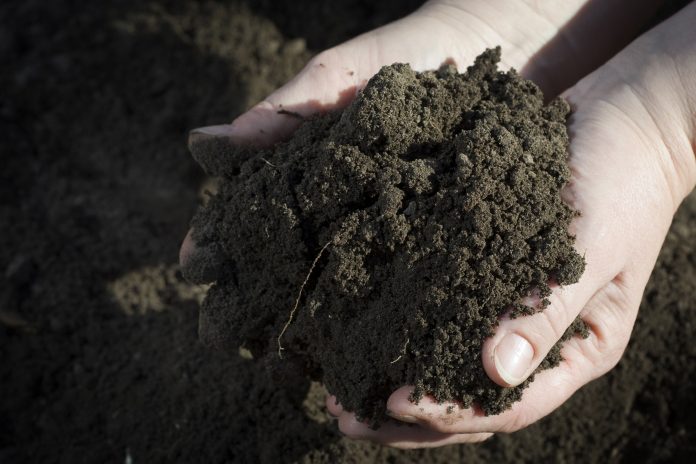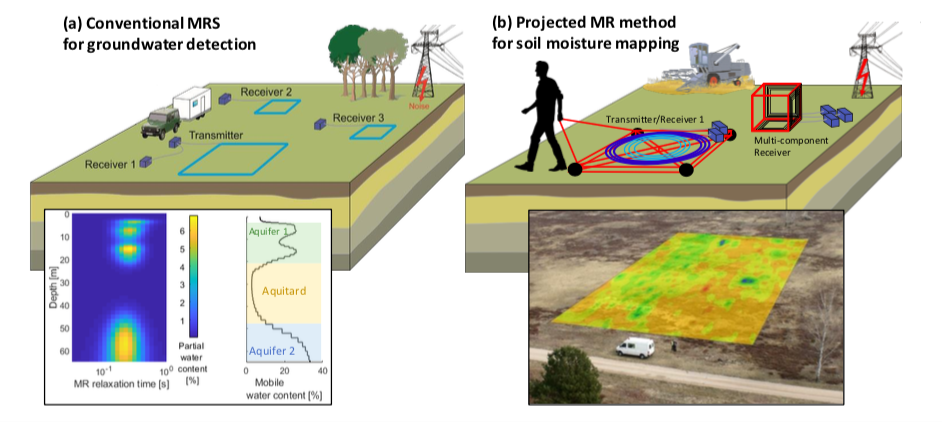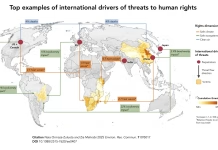Dr. Stephan Costabel, Federal Institute for Geosciences and Resources, and Prof. Dr. Mike Müller-Petke, Leibniz-Institute for Applied Geosciences, discuss the use of magnetic resonance for soil moisture mapping
The phenomenon of Magnetic Resonance (MR), observed and described by Felix Bloch and Edward Mills Purcell in 1946 for the first time, has since become the basis for a large variety of techniques in the applied sciences. MR spectroscopy analyses the chemical composition and structure of complex organic molecules. Medical MR imaging techniques provide high-resolution images of the human body. Geophysicists use MR probes to measure variations in the Earth’s magnetic field and MR borehole tools to quantify hydrocarbon resources and their productivity.
Less well known is the role of MR in the field of groundwater exploration. However, this specific application, also called MR sounding (MRS), has become more and more important during the last decade. Compared to other geophysical surface methods that might also be sensitive to water stored in porous sediments and rocks, the MR method has a significant benefit: it is exclusively sensitive to the protons in water molecules. If the detection area of the MR measurement is full of protons, the measured signal strength is at its maximum, while no protons means a zero signal. Between these two extremes a simple linear relationship exists, which makes the quantification of the water content relatively easy, whereas other geophysical methods are ambiguous in this regard.
How does MRS work?
A general requirement for performing MR measurements is a static magnetic field. For MRS, this is the Earth’s magnetic field, whereas MR applications in the laboratory necessitate strong artificial magnets. Due to their quantum-mechanical spin, protons behave like small magnets themselves. In the presence of an external field they are aligned and create an additional magnetisation parallel to that field.
MRS measurements for groundwater detection utilises large circular or rectangular cable loops laid on the ground with 10 to 150 m diameter or side length (Fig. 1a). These antennae transmit electromagnetic fields into the subsurface that manipulate the spin magnetisation of the groundwater molecules and receive the corresponding re-emitted MR signals. The amplitude of such a signal ‘counts’ the number of involved proton spins and thus estimates the water content inside the detection area.
The spatial appearance of the MRS detection area is controlled by the cable loop configuration and the strength of the transmitting field. Finally, a series of measurement repetitions with varying detection area allow the numerical reconstruction of the water content distribution beneath the loops. In this way, geological layers with significant amount of producible drinking water, also called aquifers (Fig.1a), can be identified up to a maximum depth of more than 100 meters.
The noise problem
Measuring MR in the Earth’s magnetic field has a serious drawback. Due to the low field strength, the signals are very small. Conventional MRS signals exhibit only several hundreds of nanoVolts and are normally disturbed by electromagnetic interferences, especially in the vicinity of man-made infrastructure. To produce exploitable data, advanced filter techniques must be developed to distinguish the desired MR signal from the noise. We use for instance predictive filters based on additional reference noise antennas in the neighbourhood of the primary loops (Fig.1a).
However, the noise problem multiplies for small antennas with small detection areas in the near subsurface. Corresponding signals are in the range of only several nanoVolts and can hardly be detected to date, which disqualifies the application of conventional MRS in fields such as soil sciences and safety inspection of tunnels and mines.
Outlook: Earth’s field MR for soil water mapping
Especially regarding the challenges coming along with the climate change, novel techniques are required to rapidly observe soil water dynamics in critical regions and, in doing so, to support environmental and agricultural sciences. Soils and the corresponding chemical and mineralogical cycles react sensitively on weather extremes such as long-lasting dryness and heavy rainfall events. Thus, our recent research is focused on developing a method for moisture mapping based on the MRS principle. To overcome the noise problem mentioned above, we pursue two principle strategies. First, we continuously improve our noise cancellation approaches. We could recently demonstrate that, by using a novel multi-component reference antenna (Fig.1b), the noise in problematic urban areas can be suppressed to a level that allows the detection of mobile water in a tiny multi-turn MRS coil with an area of less than one square meter (Costabel, 2019).
Second, we work on enhancing the MR signal using the so-called prepolarisation technique, which is widely used in medical MR imaging: additional coils produce strong local magnetic fields that amplify the signal response. Our modellings and experiments have shown that the field adaptation of this technique can produce amplification factors of ten to hundred at the relevant depths (Hiller et al., 2019).
We are confident that our research will lead to an MR-based system in few years that allows mapping the soil moisture at different depth from 0.1 to 2.0 meters as sketched in Fig.1b. With the help of our partners, the production of a prototype is underway. However, there are still challenges to overcome: We do not fully understand yet the proton spin dynamics in the direct vicinity of the prepolarisation coil, where enormous magnetic field strengths occur and we have to improve the overall performance to speed up the measurement progress.
References
Costabel, S., 2019, Noise analysis and cancellation for the underground application of magnetic resonance using a multi-component reference antenna – Case study from the rock laboratory of Mont Terri, Switzerland, Journal of Applied Geophysics 169, 85-97.
Hiller, T., Dlugosch, R., Müller-Petke, M., Costabel, S., 2019, The influence of non-adiabatic switch-off on the prepolarisation of
surface nuclear magnetic resonance measurements, Proceedings of Near Surface Geoscience Conference & Exhibition 2019, 8-12 September 2019, The Hague, Netherlands.
Acknowledgements
We thank T. Hiller and R. Dlugosch (LIAG) for their continuous work on modelling the complex spin dynamics, A. Chwala, Frank Bauer, and R. Stolz (Leibniz Institute for Photonic Technologies) for developing high power technology to improve the system, and Tino Radic (Radic Research) for providing us with an efficient small-scale MR device.
Please note: This is a commercial profile












